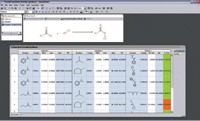Advertisement
Grab your lab coat. Let's get started
Welcome!
Welcome!
Create an account below to get 6 C&EN articles per month, receive newsletters and more - all free.
It seems this is your first time logging in online. Please enter the following information to continue.
As an ACS member you automatically get access to this site. All we need is few more details to create your reading experience.
Not you? Sign in with a different account.
Not you? Sign in with a different account.
ERROR 1
ERROR 1
ERROR 2
ERROR 2
ERROR 2
ERROR 2
ERROR 2
Password and Confirm password must match.
If you have an ACS member number, please enter it here so we can link this account to your membership. (optional)
ERROR 2
ACS values your privacy. By submitting your information, you are gaining access to C&EN and subscribing to our weekly newsletter. We use the information you provide to make your reading experience better, and we will never sell your data to third party members.
Synthesis
Digital Briefs
New Software and Websites for the Chemical Enterprise
by Noah U. Shussett
September 29, 2008
| A version of this story appeared in
Volume 86, Issue 39
Websites
Laboratree is a Web-based solution to the challenge of scientific collaboration. Indiana University School of Medicine informatics researchers designed the website to smooth research communication and social networking within an actively publishing team. It enables scientists to conduct day-to-day activities such as securely managing research papers and data, organizing groups and projects, sending group messages, writing blogs, and customizing personal and group profiles. Because the website is set up with the familiar structure of a social networking site, a user could become proficient in it in minimal time. The site is comprehensive, enabling document upload, full editing capabilities, access to all versions of a document, and edit tracking. A check-in, check-out system eliminates conflicting changes, and the site implements the recently developed OpenSocial platform, making it configurable across a number of websites. Laboratree is accessible by any Web-enabled device; the site is running and free registration is open at laboratree.org. Indiana University, www.indiana.edu
Proteopedia aims to take encyclopedia entries beyond two dimensions. The site grants access to 3-D images of biomacromolecules underlying biological functions and disease. Rather than relying on text to provide understanding of biomacromolecule structures, the collaborative website provides a new resource by linking written information and 3-D structural information. The site, designed as a wiki-style Web resource, displays protein structures and other biomacromolecules in an interactive format. Pages with images include descriptive text containing hyperlinks that change the appearance (such as view, representations, colors, or labels) of the structure to reflect the concept explained in the text, thus making the complex structural information readily accessible and comprehensible. Aside from content added by Proteopedia’s existing users, pages on each of the more than 50,000 entries in the Protein Data Bank have been automatically created with “seed” information, resulting in pages that are already useful and primed for expansion by users. Members of the scientific community are invited to request a free user account to edit existing pages and to create new ones. As a website, Proteopedia is accessible by any Web-enabled device. Proteopedia, www.proteopedia.org
Software
Lead Finder is software for virtual screening of candidate drug molecules and quantitative evaluation of interactions between protein and ligand molecules. The software ranks ligands by their predicted biological activity, determines 3-D structures of protein-ligand complexes, and estimates energy of ligand binding. The program’s built-in docking algorithm enables fast processing of large libraries of compounds to guide development for more focused libraries of active compounds. The software allows intelligent preparation of protein-structure models for docking by, for example, enabling optimization of polar hydrogen positions with respect to the ligand, substrate, and cofactor present in the structure. The software was designed to satisfy the needs of computational and medicinal chemists involved in drug discovery, of pharmacologists and toxicologists involved in the modeling and evaluation of ADMET properties—absorption, distribution, metabolism, excretion, and toxicity—in silico, and of biochemists and enzymologists working on enzyme specificity and rational enzyme design. The software operates on Windows 2000, XP, and Vista on 32- and 64-bit Intel-compatible processors, as well as on 32- and 64-bit Linux on Intel-compatible processors. BioMolTech, www.biomoltech.com
Atlas Software is an operation support system for experimental control and analysis. The application enables multiple systems such as stirrers, circulators, pumps, and balances to be intelligently combined with apparatus from virtually any manufacturer. The software offers chemistry laboratories flexibility of apparatus and vendor choice (most RS232-controlled apparatus and analog sensors can be connected to the software via a simple port that plugs into the computer’s USB connection). While running reactions, the software displays important parameters such as temperature, stirrer speed, pH, and mass flow for continuous monitoring in real time. Reaction data are continually logged to CSV data files for analysis. The drag-and-drop interface means recipes can be created, changed, and saved with a click of a mouse, enabling experiment modifications on the fly. The software runs on a PC with Windows 2000 or XP and on a Mac in Windows emulation mode. Syrris, www.syrris.com
Noah U. Shussett writes Digital Briefs. Information about new or revised electronic products can be sent to d-briefs@acs.org.








Join the conversation
Contact the reporter
Submit a Letter to the Editor for publication
Engage with us on Twitter